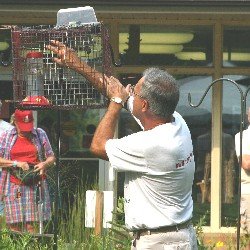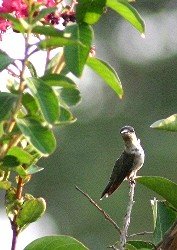There are many questions when it comes to the Ruby-throat hummingbird. Bill Hilton Jr. was kind enough to answer a great number when I spoke with him here in west Kentucky, as he was banding hummingbirds, and educating people about this little winged jewel. This is the second part to a question and answer session that I had with him.
It was a muggy, humid day that Saturday, but the Nature Station in west KY's Land Between the Lakes quickly filled with people seeking information on, or were simply curious about the Ruby-throat Hummingbird. Mr. Hilton had taken down all of the hummingbird feeders except for the one in his trap. He quickly closed the trap door by remote control, and collected a young male Ruby Throat. He quickly popped the little guy in a tube made from an index card, so that he couldn't struggle. He then started recording such data as weight, wingspan, sex, and age. Questions poured from the crowd, and he proceeded to answer them in a professional manner, but laced with his own brand of humor.
“What if I've found an injured hummingbird, what do I do?”
Hummingbirds are so tiny, that if you are not experienced in their re-hab, it’s best left to experts. Put the bird in a dark box and call your local fish and wildlife department. The only exception is that if you can gently free it from a piece of string or spider web, then do so and offer a bit of sugar water. If you have a bird that cannot fly, then call the wildlife authorities. Migratory and songbirds are protected by the Federal Government and it is illegal to catch or cage one without a permit.
“What is the final answer on commercial nectar with red dye?”
NO! Even though the dye is supposed to be harmless, why give the birds a chemical that you don’t have to? Mother Nature’s nectar is colorless and the birds do just fine. Most feeders these days have a bit of red on them anyway. You do not need the colored nectar…it looks pretty in the feeders, but is simply a sales ploy by the companies. Homemade hummingbird nectar can be easily made. Simply combine 1 part white sugar with 4 parts hot water. Do not use honey, brown sugar, or any alternate sweeteners, they go rancid faster, and can potentially harm the hummingbirds. Colored nectar has been tested on mice and proclaimed safe, but a hummingbird weighs much less than a mouse. The concentration in a hummingbird's system would be much higher.
“My hummingbirds hate each other and constantly fight. Can they hurt one another?”

Rarely do hummingbirds actually harm each other. It’s more like a couple of bulls who paw the ground, snort, and do a couple of head butts. Most of it is show. There was one instance where two male Ruby Throats were found with one of their beaks stabbed in the other’s throat…like a couple of jousting knights. It probably was an accident, as it was a one-time incident.
The best way to cut down on the squabbles is to hang your feeders out of the line of sight. If the bully hummingbird cannot see all of the feeders in the yard, he (or she) cannot guard them. It will not eliminate the problem, but it will cut down on the incidents.
Bill didn't tell me this, but another hummingbird expert several years ago made the statement, "If hummingbirds were the size of crows, we'd all be dead! They're bold, fearless, and pack a ton of attitude in those tiny bodies."
“What are the greatest threats to hummingbirds?”
Weather events are the number one threat to hummingbirds. Hurricanes, freezes, droughts, and floods. Plate glass windows collect their share, as do cats, and Sharp-shinned Hawks. Occasionally, a very large praying mantis will catch one, or a bullfrog..(yes, a bullfrog) will have one for dinner. Very few North American spiders will actually tackle a hummingbird, but spider webs are quite treacherous.
“Do the same hummingbirds return to my garden year after year?”
If you don’t think that they do, just don’t hang your feeder out and watch. You’ll have a very grumpy hummingbird hovering under the hook.
“I live in an area that is on the margin of the Ruby Throat Hummingbird’s territory. I know that they come to my area, but not to my garden. How can I attract them?”

Put your feeders out in early spring before the migration starts. Bright surveyor’s tape, or ribbon pieces tied around the garden may help. Breezes will cause the strips to move, and hummingbirds are attracted to the motion. Hummingbirds can see bright colors from a half mile away and will investigate. A popular misconception is that they fly too high to see the feeders. Hummingbirds fly low in comparison to other migrating birds, and sometimes just above ground, or ocean level. You will have a better chance of attracting hummingbirds on their northern migration in the spring, as opposed to the southern migration in the fall if you are on the edges of their territory.
“I’ve heard that migrating hummingbirds ride on the backs of migrating Canada Geese.”
Totally false. It does not happen. As stated above the hummingbird flies low. Canada Geese fly very high. It’s simply an old urban legend.
“I'm afraid that if I leave my feeder up in the fall, the hummingbirds will not migrate.”
Completely untrue. Hummingbirds will migrate when it’s time for them to do so. Nothing you can do will entice them to stay. They know when it’s time to head south, and will head in that direction when they are ready. Actually, they start migrating around the middle of July. The males head south first, then the females. People in the Ohio Valley and Mid-South see a great number of hummingbirds through this time. They are actually different birds each week, as each wave moves south, hummingbirds from further north take their place.
“There's a a tiny hummingbird-like creature in my garden. Is it a baby hummingbird?”
No. Hummingbirds are fully grown before fledging. You will see no very young hummingbirds in your gardens or at your feeders. Males will not develop the red throats until the next year, but they are full sized birds when they leave the nest. Chances are, you have seen one of the many species of Hummingbird Moths. The Snowberry Clearwing Moth flies during the day, and is often mistaken for a baby hummingbird.
Many thanks to the contributors to the Hummingbird and Butterfly Forum for suggesting many of the questions that readers see here. Their help was very valuable while preparing for this interview. So little is known about hummingbirds, and the chance to actually ask an expert in their habits and habitats gave this writer a wonderful source of material. Enjoying hummingbirds, and helping them survive, is a rewarding activity that can be very low budget, or quite lavish, depending on how much time and money one wants to invest. It is hoped that the information presented here will aid in attracting and maintaining a healthy hummingbird population.







